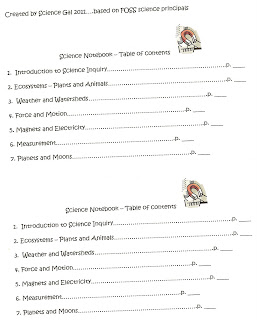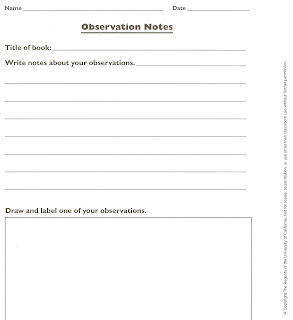On Tueday, August 9th, I am leading a workshop for my county on creating and using science notebooks in grades 3-5 for the upcoming year. I started on this journey several years ago. I must admit...the first year, they were a little bit of a mess! Yet as time goes on, and with several other workshop trainings at NSTA regional and national conferences, I feel like I have a better grip on what I'm doing. I'd like to share some of my summer planning with you....
First I start by meeting with my team members and coming up with a
common pacing guide for the upcoming year. What sequence of units will we teach? What should we change from last year? What would we like to do new? What can we do better? We had already decided to use a black composition notebook this year for our science notebooks. We prefer them to spirals (tear easily) and construction paper models (get lost easily).

Next, I plan how to set up my notebooks. I type up my
Table of Contents with the eight units for the year with a space to add page numbers. Some years I use them, and some years I use it as my guide for the students to copy as the year goes on.
After the Table of Contents, I need to add my
expectations. What will go in the notebook? I try to keep this short and sweet..limited to just eight ideas. I will have my students cut and paste this on the second page and we will refer back to it quite often during the first six weeks. I want thm to understand that not only content and vocabulary goes into these notebooks, but also questions, drawings, color, and yes...even mistakes.
The third thing I will put in to start the year will be the
Word Bank. Every unit will have a word bank and the first one is no exception. My students will lable the next clean page with the title of the first unit:
What is Science? and decorate it with pictures that come to mind when they think about science. This is always a good pre-assessment piece to see what they are thinking at the beginning of any unit. After they have drawn their pictures, then we will add the
Word Bank. Some teachers like to add this at the end of a section like a typical glossary, but I like it at the front. That way I am free to use as many notebook pages as possible. I like the flexibility of adding more pages if needed.
So...that is my starting point for now. Tomorrow I will add some reflections about why science notebooks are important to use in any 3-5 classroom......... On a side note....I am having trouble inserting my documents. The only way I could do it
for now was to scan them and insert as a picture. If anyone knows a better way, I would love some advice!
For now, gotta run!
 ss Last year, my colleague Joe and I developed this amazing beginning of the year science observation lesson. It was so much fun and the kids loved it! What's not to love when you get to see a giant explosion? We also teach the children how to observe, how to record in their new science journal, variable /constants and how to plan their very first experiment for the year!
ss Last year, my colleague Joe and I developed this amazing beginning of the year science observation lesson. It was so much fun and the kids loved it! What's not to love when you get to see a giant explosion? We also teach the children how to observe, how to record in their new science journal, variable /constants and how to plan their very first experiment for the year! 























